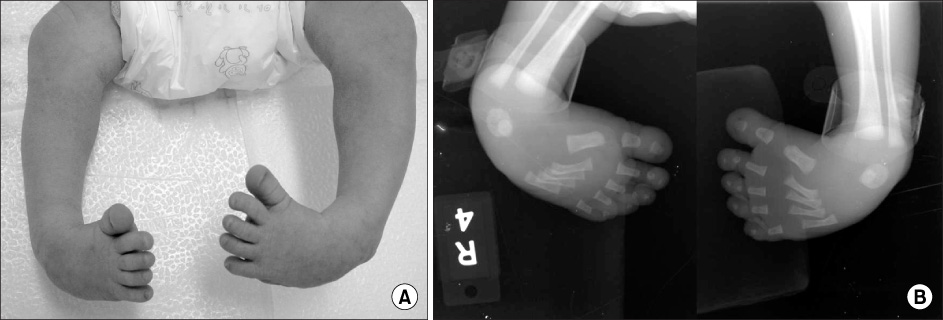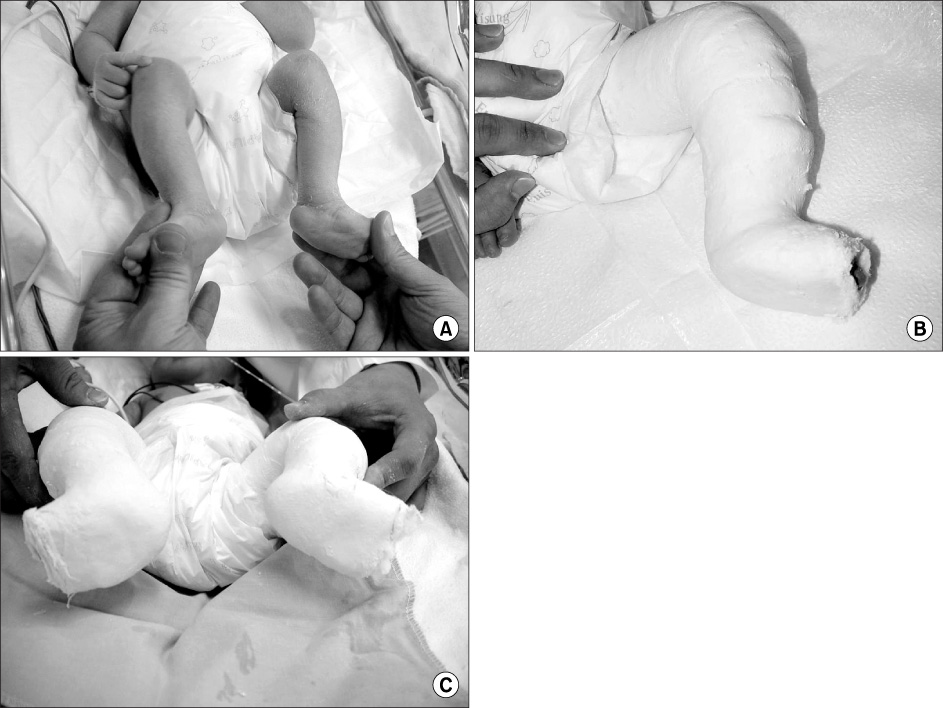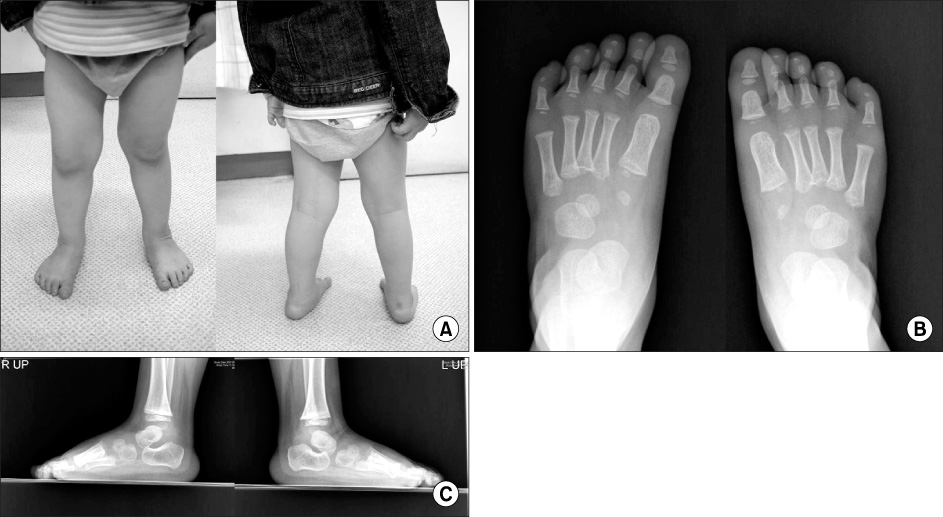J Korean Orthop Assoc.
2009 Dec;44(6):634-641. 10.4055/jkoa.2009.44.6.634.
Congenital Clubfoot Treated with the Ponseti Method
- Affiliations
-
- 1Department of Orthopedic Surgery, Samsung Medical Center, Sungkyunkwan University School of Medicine, Seoul, Korea. jss3505@skku.edu
- KMID: 2186290
- DOI: http://doi.org/10.4055/jkoa.2009.44.6.634
Abstract
- PURPOSE
This study examined the Ponseti method for the nonsurgical treatment of a congenital clubfoot.
MATERIALS AND METHODS
A total of 35 patients (52 clubfeet) were evaluated. All patients were treated by serial manipulation and casting as described by Ponseti. The patients were divided in two groups (Group 1: the result was successful and did not require extensive corrective surgery, Group 2: the result was unsuccessful and required extensive corrective surgery). The outcome in the two groups was compared in terms of the severity of initial deformity, initial roentgenographic findings, Achilles tenotomy, numbers of Ponseti casts before the Achilles tenotomy, total numbers of casting, age at the initial treatment, bilaterality, gender and compliance of the brace.
RESULTS
Twenty eight patients (42 feet, 80.7%) were corrected successfully without extensive corrective surgery (Group 1). Six patients (10 feet, 19.3%) required extensive corrective surgery (Group 2). The requirement of extensive corrective surgery was not related to the initial roentgenographic findings, number of Ponseti casts before the Achilles tenotomy, total numbers of castings, age at the initial treatment, bilaterality and gender. However, it was related to the severity of the initial deformity and compliance of the brace.
CONCLUSION
The result of a congenital clubfoot treated with the Ponseti method was successful in more than 80% of patients. It was affected by the severity of the initial deformity and compliance of the brace. However, a long-term follow-up will be needed to evaluate the recurrence and residual deformities.
Keyword
MeSH Terms
Figure
Cited by 1 articles
-
Reliable Radiologic Parameters to Predict Surgical Management for Clubfoot Treated with the Ponseti Method
Kwang Soon Song, Chang Jin Yon, Si Wook Lee, Yong Ho Lee, Sang Hyun Um, Hyuk Jun Kwon
J Korean Orthop Assoc. 2019;54(1):59-66. doi: 10.4055/jkoa.2019.54.1.59.
Reference
-
1. Dobbs MB, Rudzki JR, Purcell DB, Walton T, Porter KR, Gurnett CA. Factors predictive of outcome after use of the Ponseti method for the treatment of idiopathic clubfeet. J Bone Joint Surg Am. 2004. 86:22–27.
Article2. Kite JH. Nonoperative treatment of congenital clubfoot. Clin Orthop Relat Res. 1972. 84:29–38.3. Ponseti IV. Treatment of congenital club foot. J Bone Joint Surg Am. 1992. 74:448–454.
Article4. McKay DW. New concept of and approach to clubfoot treatment: section I-principles and morbid anatomy. J Pediatr Orthop. 1982. 2:347–356.5. Ponseti IV. Common errors in the treatment of congenital clubfoot. Int Orthop. 1997. 21:137–141.
Article6. Diméglio A, Bonnet F, Mazeau P, De Rosa V. Orthopaedic treatment and passive motion machine: consequences for the surgical treatment of clubfoot. J Pediatr Orthop B. 1996. 5:173–180.7. Herzenberg JE, Radler C, Bor N. Ponseti versus traditional methods of casting for idiopathic clubfoot. J Pediatr Orthop. 2002. 22:517–521.
Article8. Cooper DM, Dietz FR. Treatment of idiopathic clubfoot. A thirty-year follow-up note. J Bone Joint Surg Am. 1995. 77:1477–1489.
Article9. Laaveg SJ, Ponseti IV. Long-term results of treatment of congenital club foot. J Bone Joint Surg Am. 1980. 62:23–31.
Article10. Ponseti IV, Smoley EN. Congenital Club Foot: the results of treatment. J Bone Joint Surg Am. 1963. 45:261–344.11. Ponseti IV. Congenital clubfoot. Fundamentals of treatment. 1996. New York: Oxford University Press.12. Brand PW. A personal revolution in the development of clubfoot correction. Clin Podiatr Med Surg. 1997. 14:1–7.13. Miller JH, Bernstein SM. The roentgenographic appearance of the "corrected clubfoot". Foot Ankle. 1986. 6:177–183.
Article14. Weseley MS, Barenfeld PA, Barrett N. Complications of the treatment of clubfoot. Clin Orthop Relat Res. 1972. 84:93–96.
Article15. Turco VJ. Surgical correction of the resistant club foot. One-stage posteromedial release with internal fixation: a preliminary report. J Bone Joint Surg Am. 1971. 53:477–497.16. Crawford AH, Marxen JL, Osterfeld DL. The Cincinnati incision: a comprehensive approach for surgical procedures of the foot and ankle in childhood. J Bone Joint Surg Am. 1982. 64:1355–1358.17. Schlafly B, Butler JE, Siff SJ, Criswell AR, Cain TE. The appearance of the tarsal navicular after posteromedial release for clubfoot. Foot Ankle. 1985. 5:222–237.
Article18. Simons GW. Complete subtalar release in club feet. Part I--A preliminary report. J Bone Joint Surg Am. 1985. 67:1044–1055.
Article19. Lowe LW, Hannon MA. Residual adduction of the forefoot in treated congenital club foot. J Bone Joint Surg Br. 1973. 55:809–813.
Article20. Colburn M, Williams M. Evaluation of the treatment of idiopathic clubfoot by using the Ponseti method. J Foot Ankle Surg. 2003. 42:259–267.
Article21. Lovell WW, Bailey T, Price CT, Purvis JM. The nonoperative management of the congenital clubfoot. Orthop Rev. 1979. 8:113–115.22. Bensahel H, Guillaume A, Czukonyi Z, Desgrippes Y. Results of physical therapy for idiopathic clubfoot: a long-term follow-up study. J Pediatr Orthop. 1990. 10:189–192.
Article23. Seringe R, Atia R. Idiopathic congenital club foot: results of functional treatment (269 feet). Rev Chir Orthop Reparatrice Appar Mot. 1990. 76:490–501.24. Morcuende JA, Weinstein SL, Dietz FR, Ponseti IV. Plaster cast treatment of clubfoot: the Ponseti method of manipulation and casting. J Pediatr Orthop B. 1994. 3:161–167.25. Frick SL. The Ponseti method of treatment for congenital clubfoot: importance of maximal forefoot supination in initial casting. Orthopedics. 2005. 28:63–65.
Article26. Cummings RJ, Davidson RS, Armstrong PF, Lehman WB. Congenital clubfoot. Instr Course Lect. 2002. 51:385–400.
Article27. Morcuende JA, Dolan LA, Dietz FR, Ponseti IV. Radical reduction in the rate of extensive corrective surgery for clubfoot using the Ponseti method. Pediatrics. 2004. 113:376–380.
Article28. Thacker MM, Scher DM, Sala DA, van Bosse HJ, Feldman DS, Lehman WB. Use of the foot abduction orthosis following Ponseti casts: is it essential? J Pediatr Orthop. 2005. 25:225–228.
- Full Text Links
- Actions
-
Cited
- CITED
-
- Close
- Share
- Similar articles
-
- Relapse of Clubfoot after Treatment with the Ponseti Method and the Function of the Foot Abduction Orthosis
- Reliable Radiologic Parameters to Predict Surgical Management for Clubfoot Treated with the Ponseti Method
- Peroneal Nerve Dysfunction in Patients with Clubfoot Deformity: Evaluation of Clinical Presentation and Treatment
- Untreated Clubfoot in Adults (Report of Four Cases)
- Results of a Standard versus an Accelerated Ponseti Protocol for Clubfoot: A Prospective Randomized Study




